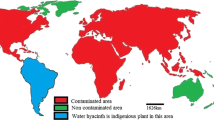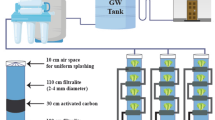Abstract
The objective of this study was to use higher plants for detecting effluent toxicity. Eight effluent samples were obtained from three industrial sources prior to their entry into a sewer system. The tests were the duckweed reproduction test, and root growth tests using cabbage and millet. The results of repeated phytotoxicity tests were reproducible. Of the three industrial sources, the effluent samples from a specialty chemical industry were the most toxic. For two samples from this source, the IC50 values (the concentrations which caused 50% inhibitory effect) for duckweed were less than 1.6% effluent concentration. The samples from an agricultural product utilization plant were the least toxic. For these samples, root growth tests failed to obtain IC50 values while the duckweed tests showed IC50 values of 91 and 43% effluent concentration. Among the three types of tests conducted, the duckweed reproduction test showed the greatest sensitivity to effluent toxicity, while root growth tests using cabbage and millet had mixed results. Duckweed is recommended as a part of a battery of tests for effluent toxicity.
Similar content being viewed by others
References
American Public Health Association, American Water Works Association, and Water Pollution Control Federation: 1985, Standard Methods for the Examination of Water and Wastewater, American Public Health Associaton, Washington, D.C.
Bellrose, F. C., Paveglio, F. L., and Steffeck, D. W.: 1979, Waterfowl Populations and the Changing Environments of the Illinois River Valley, Illinois Natural History Survey Bulletin Vol. 32, Article 1.
Bishop, W. E. end Perry, R. L.: 1981, Development and Evaluation of a Flow-Through Growth Inhibition Test with Duckweed, ASTM STP 737, Amer. Soc. Testing & Materials, Philadelphia, PA, pp. 421–435.
Charpentier, S., Garnier, J., and Flaugnatti, R.: 1987, ‘Toxicity and Bioaccumulation of Cadmium in Experimental Cultures of Duckweed, Lemna polyrrhiza L.’, Bull. Environ. Contam. Toxicol. 38, 1055–1061.
Fletcher, J. S., Vann, D. R., and McFarlane, J. C.: 1985, Database Evidence for Possible Error Between Vascular Plant and Algal Toxicity Testing, 6th Annual Meeting, Soc. Environ. Toxicol., Chem., St. Louis, MO, November, 1985.
Garten, C. T. and Frank, M. L.: 1984, Comparison of Toxicity to Terrestrial Plants with Algal Growth Inhibition by Herbicides, ORNL/TM-9177, Oak Ridge National Laboratory, Oak Ridge, TN, 43 pp.
Hartman, W. A. and Martin, D. B.: 1985, ‘Effects of Four Agricultural Pesticides on Daphnia pulex, Lemna minor, and Potamogeton pectinatus’, Bull. Environ. Contam. Toxicol. 35, 646–651.
Horning, W. B. and Weber, C. I. (eds.): 1975, Short-term Methods for Estimating the Chronic Toxicity of Effluents and Receiving Waters to Freshwater Organisms, U.S. Environmental Protection Agency, EPA/600/4-85/014, Cincinnati, OH.
King, J. M. and Coley, K. S.: 1985, Toxicity of Aqueous Extracts of Natural and Synthetic Oils to Three Species of Lemna, ASTM STP 891, Amer. Soc. Testing & Materials, Philadelphia, PA, pp. 302–309.
Nasu, Y. and Kugimoto, M.: 1981, ‘Lemna (Duckweed) as an Indicator of Water Pollution. I. The Sensitivity of Lemna paucicostata to Heavy Metals, Arch. Environ. Contam. Toxicol. 10, 159–169.
Organization for Economic Cooperation and Development: 1984, Terrestrial Plants: Growth Test, OECD Guideline for Testing of Chemicals, No. 208, Paris.
Peltier, W. H. and Weber, C. I. (eds.): 1985, Methods for Measuring the Acute Toxicity of Effluents to Freshwater and Marine Organisms, U.S. Environmental Protection Agency, EPA/600/4-85/013, Cincinnati, OH.
State of Illinois: 1986, Rules and Regulations. Title 35: Environmental Protection, Subtitle C: Water Pollution, Chapter 1: Pollution Control Board. Springfield, IL.
Thomas, J. M., Skalske, J. R., Cline, J. F., McShane, M. C., Simpson, J. C., Miller, W. E., Peterson, S. A., Callahan, C. A., and Greene, J. C.: 1986, ‘Characterization of Chemical Waste Site Contamination and Determination of its Extent Using Bioassays’, Environ. Toxicol. Chem. 5, 487–501.
U.S. Environmental Protection Agency: 1982, Seed Germination/Root Elongation Toxicity Tests, EG-12. Office of Toxic Substances, Washington, D.C.
U.S. Food and Drug Administration: 1987, Seed Germination and Root Elongation, FDA Environmental Assessment Technical Assistance Document 4.06. Center for Food Safety and Applied Nutrition and Center for Veterinary Medicine, U.S. Dept. of Health and Human Services, Washington, D.C.
Wang, W.: 1985, ‘Millet Root Elongation in Toxicity Tests of Phenolic Compounds’, Environ. Internat. 11, 95–98.
Wang, W.: 1986a, ‘Comparative Toxicology of Phenolic Compounds Using Root Elongation Method’, Environ. Toxicol. Chem. 5, 891–896.
Wang, W.: 1986b, ‘Toxicity Tests of Aquatic Pollutants by Using Common Duckweed’, Environ. Poll. (Ser. B) 11, 1–14.
Wang, W.: 1986c, ‘The Effect of River Water on Phytotoxicity of Barium, Cadmium, and Chromium lons,’ Environ. Poll. (Ser. B), 11, 193–204.
Wang, W.: 1987a, ‘Root Elongation Method for Toxicity Testing of Organic and Inorganic Pollutants’, Environ. Toxicol. Chem. 6, 409–414.
Wang, W.: 1987b, ‘Chromate Ion as a Reference Toxicant in Aquatic Phytotoxicity Tests’, Environ. Toxicol. Chem. 6, 953–960.
Wang, W.: 1987c, ‘Ni Toxicity to Common Duckweed, Lemna minor’, Environ. Toxicol. Chem. 6, 961–967.
Wang, W.: 1988, ‘Site-Specific Ba Toxicity to Common Duckweed, Lemna minor’, Aquatic Toxicol. 12, 203–212.
Wang, W. and Williams, J.: 1988, ‘Screening and Biomonitoring of Industrial Effluents Using Phytotoxicity Tests’, Environ. Toxicol. Chem. 7, 645–652.
Author information
Authors and Affiliations
Rights and permissions
About this article
Cite this article
Wang, W., Williams, J.M. The use of phytotoxicity tests (common duckweed, cabbage, and millet) for determining effluent toxicity. Environ Monit Assess 14, 45–58 (1990). https://doi.org/10.1007/BF00394356
Issue Date:
DOI: https://doi.org/10.1007/BF00394356




